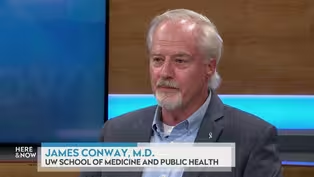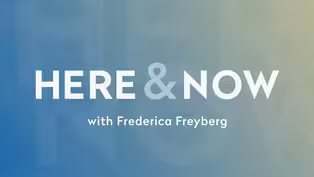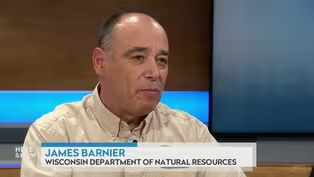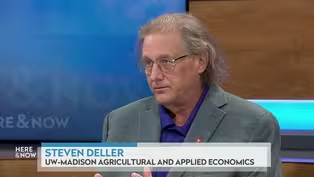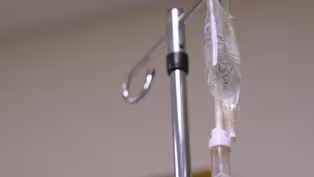Here and Now
Here & Now for August 8, 2025
Season 2400 Episode 2405 | 26m 47sVideo has Closed Captions
Watch the entire episode of Here & Now for August 8.
Watch the entire episode of Here & Now for August 8.
Problems playing video? | Closed Captioning Feedback
Problems playing video? | Closed Captioning Feedback
Here and Now is a local public television program presented by PBS Wisconsin
Here and Now
Here & Now for August 8, 2025
Season 2400 Episode 2405 | 26m 47sVideo has Closed Captions
Watch the entire episode of Here & Now for August 8.
Problems playing video? | Closed Captioning Feedback
How to Watch Here and Now
Here and Now is available to stream on pbs.org and the free PBS App, available on iPhone, Apple TV, Android TV, Android smartphones, Amazon Fire TV, Amazon Fire Tablet, Roku, Samsung Smart TV, and Vizio.
Providing Support for PBS.org
Learn Moreabout PBS online sponsorship>> The following program is a PBS Wisconsin original production.
>> Wisconsin is reporting that our first cases of measles in 2025 were confirmed over the weekend.
>> State health officials encourage vaccinations as measles hit Wisconsin and in Rx Uncovered.
Health benefit advocates help patients get the medicine they need.
I'm Frederica Freyberg.
Tonight on "Here& Now" the latest economic outlook forest land, wildfires, the rise of measles and part five of our series Rx Uncovered.
It's "Here& Now" for August 8th.
[MUSIC] >> Funding for "Here& Now" is provided by the Focus Fund for Journalism and friends of PBS Wisconsin.
>> A whole new spate of tariffs went into effect this week.
Job numbers were weaker than expected this summer, and business analysts say consumers are tightening their belts.
How do economic trends nationally translate to how Wisconsin is faring now and going forward?
We asked Steven Deller, UW-Madison professor of agricultural and applied economics, and thanks for being here.
>> Thank you.
>> So when you look at the broad economic landscape, what are you seeing.
>> From a Wisconsin perspective?
And I think this is kind of generally true across the country is a lot of businesses have gone into a wait and see mode.
That's why the job numbers are weak.
We're not seeing an increase in unemployment rates.
We're seeing a decline in the number of hires, primarily because businesses are unsure what's happening.
And when we're unsure, we kind of go into a lockdown mode.
We go into a holding pattern, if you will.
So I think that's why the job numbers are as weak as they are, and it's going to take a while for this to kind of play out.
>> And so this is this mostly around tariffs or interest rates or inflation or all of it.
>> I think it's all of it.
I think the major concern is that we're not sure exactly what the policies are going to be.
The tariffs are on.
The tariffs are off.
They're back on again.
They're off again.
And it's that uncertainty businesses I mean there's kind of we know what we know.
We know what we don't know.
We can make educated guesses.
And then what's going on.
That's uncertainty.
And when we're in a situation like that, that's when people just hunker down.
They go into wait and see mode.
And, you know, in terms of like consumers, it is kind of anticipatory shopping.
It is kind of like, okay, now let's go into a wait and see mode.
And it's just we don't know what's happening.
>> So you said that the trends kind of are the same nationally and in Wisconsin.
But is there anything specific to Wisconsin that we should be watching.
For?
>> Wisconsin?
Our highs, our growth periods are not as strong as the national averages.
Our lows are not as weak as the national averages.
So Wisconsin is kind of steady, if you will.
You have to go back to the farm crisis of the early 1980s, before Wisconsin kind of broke that trend.
So I think Wisconsin's going to be kind of in a stable mode for a little while.
>> And yet are the things that make Wisconsin more or less vulnerable to a downturn?
>> Not necessarily.
One of the reasons is because our economy is pretty diversified.
We don't we're not heavily dependent upon one particular industry.
I mean, you can point to some of the big ones, like agriculture, food recreation.
So there's some industries that maybe might be susceptible.
But in general, Wisconsin's a pretty diversified economy.
>> So all of this said, are you seeing indications of a slowdown nationally and in Wisconsin?
>> Yes.
And I think that's what the job numbers are saying.
And in talking with businesses around the state, and again, I tend to talk to the smaller businesses, which tends to dominate most of Wisconsin.
They're just in a again, a wait and see mode.
They're they're delaying expansion plans.
They're not going into shutdown mode.
And one of the reasons they're not going into shutdown mode is because they have such a difficult time hiring labor.
Wisconsin has been facing a structural labor shortage for years, long before Covid, and particularly coming out of Covid and businesses.
Remember that difficulty of hiring people, so they're really hesitant to lay people off because they don't want to go through that again.
So again, they're in that wait and see mode.
>> And so you're looking at kind of a business activity as a bellwether.
Are there others?
>> Yes.
One is consumer expenditures.
One of the things is we saw an increase in consumer expenditure after the announcement of the tariffs.
And the reason for that is people were thinking, oh, I'll buy it now.
I'll buy it before the tariffs hit.
So there was kind of a spike in spending from consumers.
Well that kind of spike has you know those purchases have played out now.
And now they're going into a wait and see mode.
So I think if we start to see consumer expenditures slow down much more than they already have, then that's a warning sign.
The other thing is we're seeing the housing market start to slow down, and there's other factors going on there.
But again, I think it's that reflection of just I'm going to delay making any major purchases because I'm not sure what's going to happen.
>> All right.
We leave it there.
Steven Deller thanks very much.
>> Thank you.
wildfires is a regular feature these days in Wisconsin.
According to current maps, there are 700 active wildfires in Canada, most of them categorized as out of control.
What's the risk of wildfires or forest fires in Wisconsin?
And could cuts in federal funding of the U.S. Forest Service?
If forest management in Wisconsin, we're joined now by James Barnier forest fire protection section chief for the Division of Forestry.
And thanks very much for being here.
>> Thank you.
>> So I know that the Wisconsin DNR also has these fire management dashboards online.
How has this year compared historically for wildfires in Wisconsin?
>> This year is fairly unique.
It was one of our more uncommon types of events.
We've had.
As you might remember, a drier than normal winter.
We saw a significant number of fires in January and February, which we traditionally don't see.
So those fires cause a lot of great a lot of work on our staff to be prepared, be ready.
Typically, when we're trying to get ready for our typical spring season, which is March, April and May.
And so that really took a toll on our staff overall from that working those two months earlier.
Traditionally, we see snowfall during that time frame.
>> Right.
>> So what are conditions like right now for fires in Wisconsin?
>> Well, to be honest, we're just starting to get back into some drought conditions.
We're starting to staff up again and just prepare for fires for the summer months.
>> When a fire breaks out.
What kind of fuels it spread?
>> Well, most of our fires are caused by people, and typically in the state of Wisconsin, most of our fires are wind driven, usually with low RH and higher temperatures, but mostly with wind.
And low RH is what we see drives most of our fires.
And that usually that light fuels that grass type fuels that would spread really fast.
And then once that gets ignited, the fire gets a lot bigger.
There's called ladder fuels.
Those ladder fuels get you know, get into the tops of the trees.
And then when you see those really significant type of crown fires.
>> So you have told us that it is not likely that Wisconsin would ever see fires like those in in Canada.
Why not?
>> Why wouldn't say we wouldn't see types of fires of that magnitude of 250,000 acres.
We probably wouldn't see that size of fires.
But we do see a lot of significant what I would say, catastrophic for the state of Wisconsin.
Anything between, you know, 3000 to, you know, 15,000 acres, those types of fires in the are common.
You know, every so often in the state of Wisconsin and have significant impacts across the state.
>> A number of DNR firefighters have been in Canada.
Tell me about that.
>> So we've sent up 20 people to both Ontario, and Manitoba.
And during that time frame in, they're actually fighting fires and working within that organization on their IMT incident management teams to help facilitate that.
So doing so, it is a significant event.
>> How much forest land does Wisconsin have and who's responsible for its management, fire prevention and firefighting.
>> Just in general, there's about 57% of the forested lands is privately owned and about another 10% industry owned.
And the rest is government entities.
And so we provide Wisconsin DNR, provide support with those landowners through, you know, sound forest management practices to provide some management plans for them or through, you know, industry working through industry foresters and ensuring that we have a good, solid forest, healthy forest to help limit those large scale fires.
>> So we know that state officials have concern about federal cuts to states from the U.S. Forest Service.
What role do the feds play in wildfire management?
>> They provide us a lot of funding sources.
So, yes, roughly a little over $2 million to support perspectives associated with wildfire preparedness.
And that where would that money go?
Well, we work heavily with our partners, local fire departments.
Our one of our key components within the state of Wisconsin.
And we provide grants to those to help facilitate responses to those fires.
Also for our needs, for our training responsibilities, our tools, our resources, and even some of our funding of our positions.
>> James Barnier, thanks very much for joining us.
>> Thank you.
>> Measles was declared eliminated in the U.S. 25 years ago, but this year marks the most cases since then, with spread of the disease to 40 states and more than 1300 cases.
Earlier this month, Wisconsin reported nine cases in Oconto County.
But health officials say they believe any spread there is contained.
Still, Wisconsin kindergartners have one of the nation's lowest vaccination rates against measles, with less than 85% of them up to date on the measles vaccine.
Last year.
That's compared to about 92.5% of kindergartners nationwide, according to the CDC.
We turn to Doctor James Conway, pediatric infectious disease specialist at the UW School of Medicine and Public Health.
And thanks for being here.
>> Happy to be back.
>> So with Wisconsin vaccination rates, how at risk are we for measles outbreaks?
a sitting duck.
You know, as we see people traveling and introducing the disease into various areas, all it takes is one person who's incubating the disease to show up in an area with under-immunized populations.
In a way, it goes.
That's really how these things get started.
>> Are you surprised that we haven't seen that kind of outbreak?
surprising given our low rates and how much travel people have been doing as we've come out of Covid and gotten back to more normal activity.
You know, we know that disease gets introduced fairly regularly.
You know, while many of them are related to the Texas outbreak, we still see cases countries.
And so all it takes is one person showing up in the right place at the right time.
>> Now, I understand that Wisconsin is one of only 13 states that has a personal conviction waiver for parents to opt out of the vaccine.
Is that opt out on the rise?
>> Yeah, it's been debated.
You know, there are medical waivers in every state, and some states also have religious waivers.
But this personal exemption waiver is something that's a little unusual.
And it really allows people that just have a deep held personal conviction to opt out of it.
Some states are discussing actually allowing more of that while other states are shutting it down and actually trying to contain that activity.
>> So what's it like for a doctor like yourself to see a preventable disease like this spreading?
>> Yeah.
It's heartbreaking.
I mean, I saw plenty of measles earlier in my career, both in my training here in the United States and in my work globally.
And, you know, as we worked so hard to eradicate polio when I was younger, measles was really the next one on the chopping block.
And in the 90s, we were very optimistic.
We were getting closer.
You know, I've seen so many children suffer with this disease.
Adults don't do well with it either.
And then having to see people unfortunately subjected to this again, you know, it's really both preventable.
And just so unfortunate.
>> How transmissible are measles?
>> Measles is probably one of the most transmissible things on the planet.
You know, we talk about the fact that you probably need about 95% of people to be vaccinated in any community to keep an outbreak from spreading.
And so when we're sitting well below 90%, you know, it's really almost something that is inevitable.
But it is by far one of the most contagious things on this planet at this point.
kind of the symptoms of, of measles, but it can be fatal.
1 to 2 people per thousand are going to be killed by this.
Probably 10% get hospitalized.
So it is, you know, really a very high risk disease, especially in young kids, the elderly, people with compromised immune systems.
But even people that survive it.
I mean, it's a miserable disease.
>> And there are certain groups that cannot get a vaccine.
And any spread would put those people at risk who who really does not get the vaccine.
>> Yeah.
So this is one of the few vaccines that's still considered a live viral vaccine.
So these are viruses that have been essentially engineered to be less transmissible, but they still can cause some symptoms in people that don't have a good immune system.
So people that have had bone marrow or other organ transplants shouldn't be getting these vaccines.
Patients that are under chemotherapy for other types of cancers, people that are on immune compromising drugs, they just can't get the vaccines.
And so they really do depend on the rest of us to essentially build a firewall for them.
>> Now, I learned that in Milwaukee, the vaccination 75%.
They are now giving out 800 doses of this vaccine.
But how at risk is a place like Milwaukee?
>> Yeah, so that's exactly the worst nightmare.
Because, you know, one of the things we need to remember about measles is people are contagious before they have symptoms.
So 3 or 4 days before you're actually ill with obvious shedding that virus.
And so when you've got even 75 or 80% of people immunized, that means 1 in 5 people are vulnerable.
Those get transmitted.
It's got a long incubation period.
So people can be walking around for weeks, not remember where they got it.
And so from a public health standpoint, chasing down where it started and getting people into quarantine and isolation is really a nightmare.
>> All right.
Well, Doctor James Conway, thanks very much.
>> Thanks for having me.
>> On health care.
We continue our coverage on prescription drugs.
Over the last month, Rx Uncovered has looked at why patient costs for drugs are going up and coverage for drugs is going down.
In our final story, patients are not alone as they try to afford their specialty drugs and navigate complex health insurance policies.
Here and now, producer Marissa Wojcik speaks with advocates helping patients understand their health plans and challenge claim denials.
>> How far are they away from bankruptcy?
>> They pretty much billed me $83,000 per infusion.
>> They are as far away as a chronic diagnosis.
>> The right medication can be expensive, but critical for chronic illness patients.
Advocates like Nilsa Cruz know this all too well.
>> The reason why I became a patient advocate is it was actually baptism by fire.
>> When she started as administrator for the Milwaukee Rheumatology Center, more than 20 years ago, she also became the clinic's de facto patient advocate.
>> Patients coming back or calling back because their medication is not covered, perhaps they cannot afford the out-of-pocket expense.
After going through a very tedious process of a prior authorization, only to come and find out that it's unaffordable, delays and denials.
Some patients suffering, too.
Because the patients really don't understand what's going on with their benefits.
>> Today, she's known and even sought out for her ability to help patients navigate complex health benefits.
>> I come to this clinic because of their patient advocate.
>> Janelle Zeihen came to Cruz when her last clinic didn't know how to help her navigate her health plan benefits.
So she came to this rheumatology clinic for her Crohn's, a type of inflammatory bowel disease.
>> It starts with like a like somebody sucker punching me right up into my chest.
And then.
And that's pretty much the inflammation starting.
>> Crohn's disease can be debilitating and life threatening, especially when not treated.
>> It is extremely painful.
I can barely walk when it happens.
Being on the entyvio that I get, it's been life changing.
>> When she got a new job, her entyvio was no longer covered under her new plan.
>> They specifically carved out all tier four drugs, which are chemo's HIV drugs and any infusions.
>> Tier four drugs are also referred to as specialty drugs.
>> When you have a complex condition, what you get slapped with is this penalty called specialty drug because a pharmacist might have to monitor or look at something more closely, which they should be doing for every drug anyway.
>> Ann Lewandowski also knows how difficult but essential it is finding the right medication.
>> Accessing it because of insurance barriers and other issues can also be as much or more challenging.
>> She has her own experience with autoimmune disorders and healthcare.
>> You're really in survival mode and you're just trying to figure out, like, do I go to work and make money?
Or do I deal with this disease?
>> Part of her expertise.
>> I am also a patient.
>> Comes from being a patient, and she uses that knowledge to help others better understand these complex systems.
>> We have these market distortions, right?
We have, depending on what your diagnosis is, who your insurance company is to patients walking in with even the same diagnosis are going to be charged completely different prices.
And I think that's really problematic.
>> I've seen plan documents where they're limiting, you know, drug expenditure, like anything over 100,000 is out.
I've seen plan documents where cancer drugs are not covered, where none of none of the rheumatology drugs are covered.
>> Often patients that can't afford an expensive drug qualify for patient assistance programs through the pharmaceutical company.
But these programs are usually for people with little to no health coverage.
>> I am insured at $400 premium cost.
>> Janelle was covered by her employer's self-funded health plan, even though it's specifically carved out her medication, leaving her to cover the cost.
>> Big time pharma is starting to say no, it's not happening.
Companies are saying these funds are patients who are literally uninsured.
Pharma will deny that free drug for the patient because benefits have been carved out and made non-essential by the plan.
And you're literally functionally uninsured.
>> Having coverage, at least on paper, disqualified her for patient financial assistance.
Why some drugs are covered by some health plans and not others is an opaque and complex system.
>> The pricing structure in this country when it comes to pricing these drugs and reimbursement, and what actual costs are, is so messed up.
It's so messed up.
>> These carve outs to not cover expensive drugs are becoming more common among self-funded health plans like Janelle's, which are governed by different laws than fully insured health plans.
>> We know health insurance can be complicated and confusing.
>> Secretary Nathan Houdek oversees the office of the Commissioner of Insurance.
>> And what makes it even more confusing for people is that health insurance is really regulated by a number of different agencies at both the federal and state levels.
>> This state agency regulates fully insured health plans.
If a patient wants to challenge an insurance denial, they come here.
don't understand if they have employer sponsored coverage is whether that's fully insured coverage or whether that is self-funded coverage.
>> Self-funded coverage is regulated by federal law, but you can still start with this office.
>> If someone has health insurance coverage through a self-funded plan, then we will kind of hand them off to we like to refer to as kind of a warm handoff to the Department of Labor, because it's the federal Department of Labor that actually regulates self-funded plans.
>> Because of this, no matter what kind of plan, Secretary Houdek recommends reaching out.
>> Unfortunately, studies have shown that of all the coverage and claim denials, only a small percentage are appealed.
And that's really because people don't know what their rights are.
People don't know that there is a place where they can turn to answer questions, to be a resource, and our office is here to help with that.
>> Fully insured versus self-funded plans.
Health experts say they both have their own issues.
The rules are just different.
>> I have a lot of empathy for employers, right?
I mean, if you are a manufacturer here in Wisconsin.
You're making cheese.
You're making steel parts, whatever.
Making yachts.
It really doesn't matter.
You are not a health care expert.
>> For Janelle, her case was even more complicated than most.
But Cruz was with her every step of the way.
>> First of the year go through.
conversation, Janelle, you literally told me I'm just settle on not getting my treatment this year.
>> She helped Janelle file a complaint with the US Department of Labor.
>> Please keep in mind that for any given patient to file a complaint with the Department of Labor takes guts because you're now dealing with filing a complaint against your employer.
And the fear of getting fired, even though it's totally illegal.
>> It does make it hard to go into work, because I also don't know if I'm going to be walking into work and being walked out because of this.
And for retaliation or whatnot.
>> There are still these very gray questions of law that honestly make me a little scared to be a patient and speak up and encourage people to exercise their legal rights, which are to speak to their employer and say, hey, this is a wrong denial.
>> During open enrollment, Janelle decided not to use her employer's health plan, opting to find a fully insured one on the marketplace.
my employer, I would be right back to where I would start and that would be just that's not even an option.
>> She pays more in premiums, but her medication is covered without the help of advocates.
Many patients are left deciding between their medication or their savings.
>> Can patients do this themselves?
Probably not, because the statistics have shown that very few patients will take it to the next level.
It's too cumbersome.
If you look at denial letters, the steps are in there and it's Yvonne cumbersome for me.
However, having said that, I'm constantly looking for ways to make it easier for my patients to appeal.
>> For her patients.
Cruz goes all in to help them find relief.
>> Thanks for everything.
>> Relief from the physical pain of a chronic illness and relief from the financial pain of treating it.
Reporting from Milwaukee.
I'm Marissa Wojcik for "Here& Now".
>> For more on this and other issues facing Wisconsin, visit our website at PBS Wisconsin.
Org and then click on the news tab.
That's our program for tonight.
I'm Frederica Freyberg.
Have a good weekend.
[MUSIC] >> Funding for "Here& Now" is provided by the Focus Fund for Journalism and
Dr. James Conway On Wisconsin's Risks of Measles Outbreaks
Video has Closed Captions
Clip: S2400 Ep2405 | 5m 2s | Dr. James Conway on a measles outbreak in Oconto County and a low state vaccination rate. (5m 2s)
Here & Now opening for August 8, 2025
Video has Closed Captions
Clip: S2400 Ep2405 | 56s | The introduction to the August 8, 2025 episode of Here & Now. (56s)
James Barnier On The Potential for Wildfire Around Wisconsin
Video has Closed Captions
Clip: S2400 Ep2405 | 4m 34s | James Barnier on risks of large and widespread wildfires as federal funding is cut. (4m 34s)
Steven Deller On Tariffs, Job Numbers and Economic Trends
Video has Closed Captions
Clip: S2400 Ep2405 | 4m 56s | Steven Deller on what new tariffs, jobs and spending figures mean for the economy. (4m 56s)
Why Complex Health Benefits Are a Focus of Patient Advocates
Video has Closed Captions
Clip: S2400 Ep2405 | 10m 30s | Patient advocates work to navigate complex health plans to find opportunity and options. (10m 30s)
Providing Support for PBS.org
Learn Moreabout PBS online sponsorship
- News and Public Affairs

Top journalists deliver compelling original analysis of the hour's headlines.

- News and Public Affairs

FRONTLINE is investigative journalism that questions, explains and changes our world.












Support for PBS provided by:
Here and Now is a local public television program presented by PBS Wisconsin
